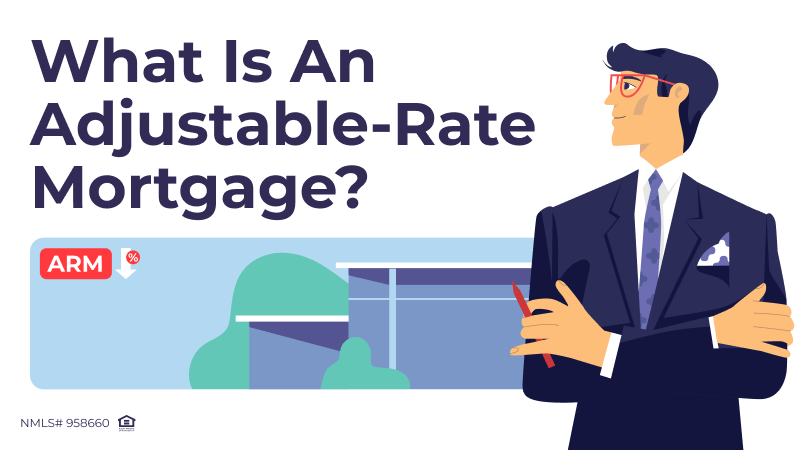
An adjustable-rate mortgage (ARM) is a smart choice for borrowers who expect their financial situation to change or plan to move before the fixed-rate period ends. Your clients can save a lot of money in the beginning of their mortgage, giving them some extra cash and the ability to adapt to any future economic changes. How? ARM loan has a lower interest rate at the beginning, unlike regular fixed-rate mortgages. This rate stays the same for 5, 7, or 10 years so you can save money and have lower monthly payments. This makes ARMs particularly appealing when interest rates fluctuate.
It’s important to know that after the first part of your mortgage ends, the interest rate can change. This could mean paying more each month, so it’s essential to be ready for that. Knowing all about ARM loans is vital when choosing what will work best for your long-term financial plans.
Definition of an Adjustable-Rate Mortgage
Struggling with a loan scenario?
Get a solution in 30 minutes!Fill out the short form and get a call from our AE
Submit a ScenarioAdjustable-Rate Mortgage (ARM) is a type of home financing where the interest rate applied on the outstanding balance varies throughout the life of the loan.
Unlike a fixed-rate mortgage, where the interest rate remains constant, an ARM starts with a predetermined period during which the rate is fixed, typically lasting anywhere from 5 to 10 years. This initial phase offers predictability in payments and can often feature lower rates compared to fixed-rate mortgages, providing an attractive entry point for borrowers.
After the initial fixed period, the mortgage transitions into an adjustable phase where the interest rate changes periodically based on a referenced index such as the Secured Overnight Financing Rate (SOFR) or the London Interbank Offered Rate (LIBOR).
These adjustments reflect changes in market interest rates and can lead to varying monthly payments. The structure of an ARM helps balance initial stability with long-term flexibility, catering to borrowers who may have evolving financial situations or those planning for shorter-term homeownership.
How Does an ARM Loan Work?
As mentioned previously, adjustable-rate mortgage (ARM) functions in two primary phases: the initial fixed-rate period and the subsequent adjustable period.
First, the ARM offers a fixed interest rate, which remains unchanged for a set period, typically ranging from 5 to 10 years. This phase provides stable, predictable monthly payments, allowing borrowers to plan their finances with certainty during this period. The fixed-rate phase is particularly beneficial for those who may be new to homeownership or are seeking temporary stability in their financial commitments.
Following the fixed-rate term, the ARM enters its adjustable phase, where the interest rate begins to fluctuate based on prevailing economic indices. One common benchmark for these adjustments is the Secured Overnight Financing Rate (SOFR), which reflects the cost of borrowing cash overnight collateralized by U.S. Treasury securities. Other indices like the London Interbank Offered Rate (LIBOR) have historically been used, though many ARMs are transitioning to more stable and transparent rates like SOFR.
The rate adjustments occur at predetermined intervals, such as annually, after the initial fixed period ends. These adjustments are influenced by different factors. These can include changes in the broader economic environment, central bank policies, and movements in the financial markets. Adjustable phase requires borrowers to be adaptable, as their monthly payments may increase or decrease based on the direction of the adjustment.
By understanding these phases and the factors influencing rate changes, borrowers can better anticipate how their payments might vary and plan accordingly. This structure allows for initial cost savings while adapting to long-term financial market trends.
Types of ARM Loans
Adjustable-Rate Mortgages (ARMs) come in various formats. Common types include the 5/1 ARM, 7/1 ARM, and 10/1 ARM.
The numbers in these designations explain how the loan’s interest rate will change over time. The first number indicates the length in years that the initial interest rate remains fixed, while the second number describes the frequency, in years, of rate adjustments after the initial fixed period ends.
For example, a 5/1 Adjustable Rate Mortgage means that the interest rate is locked for the first five years and then adjusts once every year thereafter. Similarly, a 7/1 ARM holds the rate steady for seven years before transitioning to annual adjustments. The 10/1 ARM offers a decade of rate stability, followed by yearly changes.
These types of ARMs provide varying degrees of predictability and risk, allowing borrowers to choose a mortgage that best aligns with their future financial plans and how long they intend to hold the property.
Pros and Cons of ARM Loan

Looking for a suitable loan program?
Choose among 20+ programs and get
a detailed loan calculation
Adjustable-Rate Mortgages (ARMs) offer distinct advantages and disadvantages that are crucial for borrowers to understand when choosing the best mortgage option for their financial situation.
Advantages
- Lower Initial Payments. ARMs typically start with lower interest rates compared to fixed-rate mortgages, making them more affordable in the early years of the loan. This can be particularly advantageous for buyers expecting an increase in income over time.
- Potential for Rate Decreases. If interest rates fall, borrowers benefit from reduced payments without needing to refinance, unlike with a fixed-rate mortgage.
- Flexibility. ARMs are ideal for those who plan on moving or refinancing before the rate adjusts, such as in cases of short-term residency.
Disadvantages
- Risk of Rate Increases. After the initial fixed period, rates can increase based on market conditions, potentially leading to significantly higher monthly payments.
- Complexity and Uncertainty. The variable nature of ARMs can be complex to understand. The uncertainty of future payments can make financial planning challenging.
- Prepayment Penalties. Some ARMs come with prepayment penalties, making it costly to refinance or sell the home before a certain period.
These pros and cons highlight the importance of borrowers assessing their financial stability, future income prospects, and tolerance for risk before deciding on an ARM. This assessment will determine if the potential savings during the initial period outweigh the risks of fluctuating rates later.
ARM Loan vs Fixed-Rate Mortgages
When comparing Adjustable-Rate Mortgages (ARMs) with fixed-rate mortgages, it’s crucial to consider individual financial scenarios to determine which fits best.
ARMs may be more advantageous in certain situations due to their initially lower interest rates. This feature is particularly beneficial for those who plan to move or refinance before the adjustable period begins, such as individuals on temporary job assignments or those anticipating an increase in future earnings. Additionally, if interest rates are expected to decline over time, an ARM could continue to be cost-effective even after the rate adjustment period starts.
Conversely, fixed-rate mortgages offer unparalleled predictability and stability, which are highly valued in a volatile economic climate. The interest rate remains constant throughout the term of the loan, providing a consistent monthly payment that facilitates easier budgeting and long-term financial planning. This consistency is especially appealing to homeowners who intend to stay in their homes for an extended period and prefer to know exactly what their payments will be.
In essence, the choice between an ARM and a fixed-rate mortgage largely depends on the borrower’s financial stability, risk tolerance, and long-term housing plans.
Who Should Consider an ARM Loan?
Ideal candidates for an ARM include those who anticipate a rise in their income or those who plan to own their home for only a short period. For example, young professionals expecting career advancement and salary increases may find the lower initial payments of an ARM manageable and economically advantageous.
Similarly, individuals who are likely to relocate for work or personal reasons before the end of the fixed-rate period can take advantage of the initial lower rates without facing the uncertainty of rate adjustments in the future.
Additionally, savvy investors or homebuyers who keep a close eye on market trends and economic forecasts might choose an ARM to capitalize on potential rate decreases over time. This strategy can be particularly effective in a declining interest rate environment where future adjustments could lower their monthly payments.
ARMs fit borrowers who are confident in their future financial stability, are comfortable with a certain level of risk, or have a clear understanding of their short-term housing needs and market conditions. These mortgages offer flexibility and initial cost benefits that can align well with specific financial goals and life situations.
Rate Caps and Safeguards
Rate caps are a crucial safeguard in Adjustable-Rate Mortgages (ARMs). They protect borrowers from drastic increases in interest rates. These caps set a limit on how much the interest rate can rise during each adjustment period and over the life of the loan.
For example, an annual cap might restrict rate increases to 2% per year, while a lifetime cap could limit total increases to 6% above the initial rate. These provisions ensure that borrowers are not overwhelmed by sudden, substantial hikes in their monthly payments.
Other safeguards for ARMs include initial rate caps, which specifically limit the first adjustment after the fixed-rate period, providing additional security to borrowers as they transition to potentially higher rates. Some ARMs also feature payment caps that limit the amount a monthly payment can increase at each adjustment, independent of interest rate changes, helping to maintain affordability.
Conclusion
Adjustable-Rate Mortgages (ARMs) offer a flexible alternative to traditional fixed-rate mortgages. They are ideal for certain borrowers under specific financial circumstances. ARM loan typically starts with lower initial rates that remain fixed for a predetermined period, providing cost-effective solutions for those who plan short-term homeownership or expect future income growth. However, the subsequent adjustable phases introduce variability based on market conditions, which requires careful consideration of future financial stability and risk tolerance.
While ARMs can offer significant initial savings, they also carry the risk of increasing rates, which can impact long-term affordability. Understanding the types of ARMs, including their rate structures and adjustment intervals, alongside safeguards like rate caps, is crucial for managing these risks effectively.
Given the complexity and long-term commitment involved in choosing the right mortgage, we strongly recommend consulting with mortgage professionals at A&D Mortgage.


